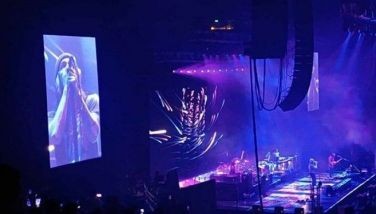K-pop a source of national pride
SEOUL — The Korean entertainment industry continues to be a vibrant force in the Asian region. For decades, Korea has been an export powerhouse in electronics, ships and cars, but now Korean dramas and K-pop music have become huge cultural exports, giving the country some national pride.
Korean dramas and K-pop are now known all over the world as Hallyu or the Korean wave. According to recent government statistics, K-pop exports grew nearly 50 percent from 2011 to 2013, grossing an estimated $290M in 2014.
Broadcasting exports such as TV dramas hit $25M in 2012, up from $185M in 2009, while K-pop music earned $177M in 2010, soaring from only $31M in 2009.
“When it comes to Korean culture, Hallyu or the Korean wave is always included,” Dr. Hyun-seok-Yu, president of the Korean Foundation, told the journalists who participated in the second Asean-ROK Next-Generation Opinion Leaders Program recently held here.
According to the country’s Defense Ministry, K-pop has become an important “weapon” against North Korea, when Seoul recently blasted K-pop music on the border as retaliation to the country’s provocations, calling it the “surest and effective psychological warfare.”
The Opinion Leaders Program participants, who came from Brunei, Cambodia, Lao PDR, Myanmar, Indonesia, Thailand, Malaysia, Singapore, Vietnam and the Philippines, got a taste of the K-pop vibe for six days.
The conference/familiarization tour aims to support and promote Korean education studies worldwide, in addition to bringing the richness of Korean culture to global audiences.
Part of the itinerary was a tour to various entertainment facilities now open for Hallyu tourists.
There’s the newly-opened MBC theme park called MBC World and the SMTown@coexatrium that features the top K-pop artists in Asia and the world.
Based on the country’s recent tourism data, 30 percent of foreign tourists are visiting South Korea because of their love for K-pop, K-dramas and anything Hallyu.
In the Philippines, one of the most popular K-pop bands these days is EXO, a group made up of 10 South Korean and Chinese members, which is slated to hold a concert in Manila on Jan. 23. The demand for the boy band was so high that the first date sold out in hours, resulting in the immediate addition of a second show on Jan. 24.
And we have learned that super avid fans of EXO go to Korea to visit the SMTown@coexatrium, a facility built by SM Entertainment, one of the hugely successful labels and talent agencies in Korea managing EXO, Girls Generation (GG), Super Junior, F/X, Red Velvet, Shinee and Boa.
According to government data, it was SM Entertainment who started K-pop in the ‘90s and has a market capitalization of $660M. For the first six months of 2014, SM Entertainment posted $849M in operating profit.
Seong Son Kim, professor emeritus and former dean at the Seoul National University (SNU) cited Girls Generation’s achievement in spreading K-pop music to the world. GG’s precision-tooled choreography, slick videos and infectious pop hits have helped define the K-pop genre, Prof. Kim said.
“Girls Generation is the first Korean group to guest on America’s main talk show The Late Show with David Letterman in February 2011,” Kim told the delegates during a brief lecture on the history of the Korean culture, particularly the rise of Hallyu abroad.
In less than five years since it was established in 2007, the nine-piece girl band has amassed sales of more than 30M digital singles and 4.4M albums as of 2012.
At SMTown@coexatrium, the clothes, costumes and other memorabilia of GG are displayed, along with other artists.
Built in January last year, the facility features the actual recording studio that SM artists use. Our tour guide Kim said the SMTown@coexatrium is also a venue where fans can live out their dreams of being like their K-pop idols.
For 2M won (or around P78,000), you can avail hair and styling like a true K-pop idol, get to record in a music studio and afterwards, star in your own music video. You even have a vocal coach and most importantly, you will get to take home a shiny, new album. Kim said you have to book for an appointment and the whole process takes a day.
The second floor houses the celebrity shop where everything — from pens to fans to shirts bearing the faces of SM artists — is sold.
The third floor has the EDUtainment studio while the fifth and sixth floors house the SMTown Theater, where you can find Korea’s first hologram theater that combines the latest technologies and contents.
After our visit to SMTown@coexatrium, we headed next to the MBC Theme Park. Located at the MBC headquarters in Sangam-dong in northern Seoul, the theme park was established for tourists who want to see or experience Hallyu content in 360-degree virtual reality.
“Many tourists come to the country pursuing their love for Hallyu content, but find that few related activities are available and simply end up shopping,” MBC said in a statement.
That’s why MBC thought of developing a theme park where fans can interact or experience an immersive Hallyu experience.
On the first floor, you’ll find a hologram theater where you can watch concerts featuring Psy and 2NE1. Psy is a K-pop juggernaut, who broke records for having the most-watched YouTube video with his single Gangnam Style. 2NE1, on the other hand, is one of the most popular girl bands and has collaborated with top US producers, including rapper P. Diddy. One of 2NE1’s members is Sandara Park, who had a showbiz career in the Philippines before returning to Korea.
Fans of K-dramas will find the virtual reality drama sets and photo booths on the fifth floor a sight to behold.
You can take photos beside the characters in beloved Korean series Jewel in the Palace and Winter Sonata.
On the first floor, the delegates had a ball watching K-pop groups like Apink, Got7 and BTS in hologram forms who taught them the choreography of their dance songs.
Established in 1961, MBC or Munhwa Broadcasting Corporation is considered the No. 1 broadcast network in Korea. It has been contributing to the development of the media industry, covering 98 percent of the nation with a network of 18 regional stations and 10 subsidiaries. Today, it’s a multimedia group with one terrestrial TV channel, three radio channels, five cable channels, four satellite channels and four decibel milliwatts (DBM) channels.
“MBC dramas are exported to more than 50 countries. The network provides useful information and entertains the viewers through its channels, while focusing on the core value of delivering customer satisfaction based on fairness, reliability, creativity and professionalism,” Prof. Kim said.
Meanwhile, many are wondering why K-pop videos look so slick and cool, and scenes in Korean dramas look like live photographs. It turned out there is an agency that helps take care of all that.
An entertainment conglomerate, the Creative Center for Convergence Culture (CJ E&M) is considered Asia’s No. 1 media company, tasked to develop and produce premium Korean content for their broadcast, film, music and live entertainment businesses.
In an interview with Lee Hyung Min, CJ E&M managing director of Creatives, he said the conglomerate aims to introduce Korean content to countries around the world through its many ventures in Southeast Asia, the US and Japan, among others.
- Latest
- Trending


























 Exclusive
Exclusive